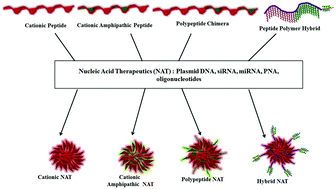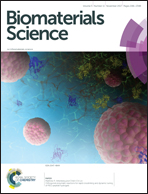Peptides, polypeptides and peptide–polymer hybrids as nucleic acid carriers
Abstract
Cell penetrating peptides (CPPs), and protein transduction domains (PTDs) of viruses and other natural proteins serve as a template for the development of efficient peptide based gene delivery vectors. PTDs are sequences of acidic or basic amphipathic amino acids, with superior membrane trespassing efficacies. Gene delivery vectors derived from these natural, cationic and cationic amphipathic peptides, however, offer little flexibility in tailoring the physicochemical properties of single chain peptide based systems. Owing to significant advances in the field of peptide chemistry, synthetic mimics of natural peptides are often prepared and have been evaluated for their gene expression, as a function of amino acid functionalities, architecture and net cationic content of peptide chains. Moreover, chimeric single polypeptide chains are prepared by a combination of multiple small natural or synthetic peptides, which imparts distinct physiological properties to peptide based gene delivery therapeutics. In order to obtain multivalency and improve the gene delivery efficacies of low molecular weight cationic peptides, bioactive peptides are often incorporated into a polymeric architecture to obtain novel ‘polymer–peptide hybrids’ with improved gene delivery efficacies. Peptide modified polymers prepared by physical or chemical modifications exhibit enhanced endosomal escape, stimuli responsive degradation and targeting efficacies, as a function of physicochemical and biological activities of peptides attached onto a polymeric scaffold. The focus of this review is to provide comprehensive and step-wise progress in major natural and synthetic peptides, chimeric polypeptides, and peptide–polymer hybrids for nucleic acid delivery applications.



 Please wait while we load your content...
Please wait while we load your content...